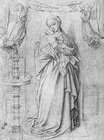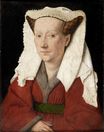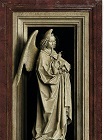Jan van Eyck - Portrait of Margaret van Eyck 1439
 |
 |
 |
 |
 |
 |
 |

Portrait of Margaret van Eyck 1439
32x25cm oil on panel
Groeningemuseum, Bruges, Belgium
<< Previous G a l l e r y Next >>
From Wikipedia, the free encyclopedia:
Portrait of Margaret van Eyck (or Margaret, the Artist's Wife) is a 1439 oil on wood painting by the Early Netherlandish master Jan van Eyck. It is one of the two latest of his surviving paintings, and one of the earliest European artworks to depict a painter's spouse. Completed when she was around 34, it was hung until the early 18th century in the Bruges chapel of the Guild of painters. The work is thought to be a pendant or diptych panel for either a now lost self-portrait known from records until 1769, or of Jan van Eyck's likely self-portrait now in the National Gallery in London.
The reason for its inception is unknown; but that it was created for private rather than public viewing can be inferred from the sitter's unidealised representation and her direct but plaintive gaze towards the viewer, which creates an intimate and informal atmosphere. The painting was probably created to mark an occasion; maybe to commemorate the couple's anniversary, or her birthday, or as a gift to her.
Van Eyck died within two years of this work. He inscribed plates on the top and ends of the frame in Greek lettering with the words, My husband Johannes completed me in the year 1439 on 17 June, at the age of 33. As I can. "As I can" (ALS ICH KAN) was something of a personal motto and motif for van Eyck, as well as a pun on his surname. It can be found inscribed on several of his religious paintings, though on only two portraits.